羊
Download as pptx, pdf0 likes355 views
A document provides examples of how to make a goat, including using a 3D printing machine or sculpting clay and hardening it in the oven.
1 of 17
Download to read offline


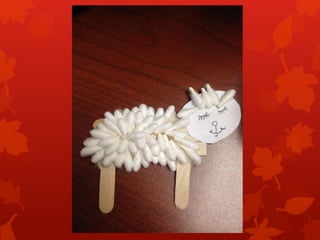
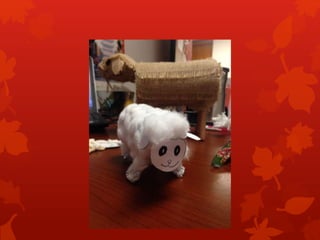

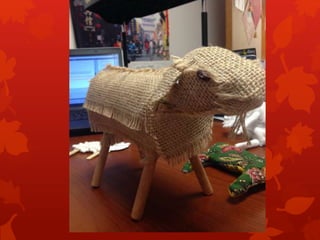

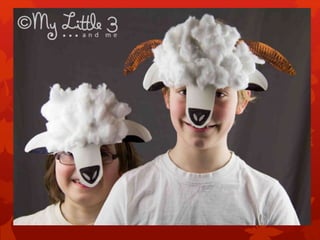

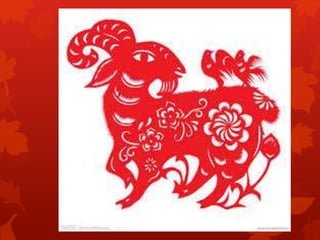







Ad
Recommended
汉字
汉字Shilaoshi
?
本文介绍了汉字的起源及演变,提到仓颉作为汉字的传说创造者。它还概述了汉字在中国及其周边国家(如日本和韩国)的使用情况及不同书体的发展。包括甲骨文、金文、大篆、小篆、隶书和楷书等汉字演变的关键阶段。4.3 time
4.3 timeYanxinliu
?
本文档提供了汉语中对于时间表达的基本词汇和句型,包括询问时间、整点、半点、刻和分等的表达方法。它通过示例句展示了如何用中文问现在几点以及不同时间的表述方式。文档也包含了多个时间的实例,以帮助学习者理解和使用这些词汇。笔1第一课
笔1第一课javertian
?
The students are going to the school field to play games and do activities like reading books and writing words. They are carrying their school bags and asking how everyone is doing on their way to school on a sunny early morning.20150116北京地铁
20150116北京地铁Shilaoshi
?
北京地铁自1965年开通以来已发展至230公里的总运营长度,设有近150座车站,每日乘客超过500万。其运营线路包括1号线、2号线等,采用单一票价制,单程票价为人民币2元。地铁技术先进,且北京地铁近年来发展迅速。Radical1 1027
Radical1 1027Shilaoshi
?
该文档包含多个汉字、部首及其对应的拼音,同时列出了不同植物和自然元素的名称。内容涉及很多与自然相关的词汇,如树木、花朵和水体的名称。文档的整体结构是以汉字和拼音配对的形式呈现。笔画和笔顺
笔画和笔顺Yanxinliu
?
This document discusses strokes and stroke order in written Chinese characters. It introduces the basic strokes - dot, horizontal, vertical, fall, rise, and hook strokes. It provides examples of characters and the strokes they contain. It explains that learning proper stroke order is important as it makes learning and writing characters easier and more effective. There are only eight basic stroke order rules to remember that dictate the sequencing of strokes from top to bottom, left to right, inside to outside etc. Mastering these rules from the beginning establishes a habit of writing characters correctly. The document concludes by noting Chinese characters can be broken down into single, top/bottom, left/right, and left/center/right structures.我喜欢吃……,我喜欢喝……。
我喜欢吃……,我喜欢喝……。Yanxinliu
?
这是一篇对于个人喜好的文档,内容涵盖了作者以及其家庭成员的饮食习惯。作者和家人谈论了他们喜欢和不喜欢的食物和饮料,包括水果、汤、饮料等。文中使用了基本的中文词汇和句子结构,适合语言学习者。P1 How to speak chinese in 10 hours -S01-S76 basic abc
P1 How to speak chinese in 10 hours -S01-S76 basic abc LEGOO MANDARIN
?
The document provides an introduction to basic Chinese, emphasizing that it is a pictorial language without an alphabet, utilizing radicals and characters to form words and phrases. It outlines the structure of Chinese grammar, including sentence order, verb tenses, and the absence of conjugation, gender, or plurals, which contrasts with many other languages. Additionally, it explains the tone distinctions in pronunciation that can change meanings of words, along with various vocabulary related to time and numbers.你几点上课?
你几点上课?conglaoshi
?
The document explains how to express time in Chinese, using 点 (hour), 分 (minute), and 半 (half) for different time formats. It also covers distinguishing between AM and PM, the order of time words in sentences, and provides examples for translating various sentences related to class timings. Additionally, it introduces the use of 是 to denote 'am/is/are' in sentences.Chinese link textbook Lesson 5 dialogue
Chinese link textbook Lesson 5 dialogue Joanne Chen
?
1) Joanne introduces Wenzhong to her roommate Wang Hong and her friend Wenzhong.
2) Wang Hong asks Li Wenzhong if he has roommates, to which he replies that he has two roommates.
3) When asked their names, Li Wenzhong responds that his two roommates are Ding Ming and Fang Xiaowen, and that they are both Chinese, as he often speaks Chinese with them.Chinese Measure Words 2
Chinese Measure Words 2ErinPPT
?
This document discusses Chinese measure words, which are used to count nouns in Mandarin Chinese. It provides examples of common measure words like "个" and "棵" and explains that a measure word must be used between a number and a noun. It also includes pictures and asks questions to prompt learning about different measure words used for people, animals, plants, buildings and containers.Chinese Link textbook Lesson 1 core vocabulary
Chinese Link textbook Lesson 1 core vocabularyJoanne Chen
?
This document provides vocabulary and phrases for a basic Chinese lesson. It introduces common greetings like "Ni Hao" meaning "Hello" as well as words for "I", "you", "good", "student", and "teacher". Examples sentences show how to ask questions using words like "ma" at the end or make tag questions using "ne". Additional vocabulary includes words for "also", "no", and "very". The document models basic conversations and questions asking if someone is a teacher or student.Chinese Link Textbook Lesson 2 vocabulary
Chinese Link Textbook Lesson 2 vocabularyJoanne Chen
?
This document provides Chinese vocabulary and grammar structures for introducing oneself and asking basic questions. It includes terms for asking and stating one's name, asking what someone's name is called, asking who someone is, and forming negative sentences. Sample dialogues are provided that demonstrate using these terms, such as asking and answering "What is your name?" and "How are you?". The document teaches polite and respectful ways to ask for someone's last name in Chinese culture.Chinese Link Lesson 6 sentence patterns
Chinese Link Lesson 6 sentence patternsJoanne Chen
?
This document contains sample questions and responses for learning Mandarin Chinese. It includes questions about family, occupation, place of origin, studies, and pets. Sample questions ask where someone is from, how many people are in their family, what their father's occupation is, and what they study. Responses provide details about having a family of four people and a father who is an engineer. 生日
生日Yanxinliu
?
文档提供了一系列对于日期和月份的信息,包括各种家庭成员的生日问答句型。它列出了一月份到十二月份的中文和英文名称,以及具体的日期表达方式。通过示例,本文件帮助学习者了解如何询问和回答有关生日的问题。几
几Yanxinliu
?
The document contains examples of conversations in Chinese where speakers ask how many family members, pets, brothers, sisters, cats, or dogs another person has. Sample responses are provided such as "I have 3 people in my family", "I have 2 younger sisters", or "I have 1 cat". The conversations follow a pattern where one person asks "你有几个/只 [noun]" and the other responds with "我有[number] [noun]" to indicate quantity.口
口Yanxinliu
?
The document discusses the Chinese measure word "kou" which is used in northern China to refer to the number of family members. It provides three examples sentences using kou to describe families with 3, 6, and 8 members respectively, including parents, siblings, pets. The word "ge" is used instead of "kou" in southern China for counting family members.谁1
谁1Yanxinliu
?
This document discusses how to ask and answer questions about who someone is in Chinese. It provides examples of asking "who is he?" and the answers using the names Liu Laoshi, Jackie Chan, Lin Shuhao, Yao Ming, and Bruce Lee. Short biographies are included for Lin Shuhao, Yao Ming, and Bruce Lee.个
个Yanxinliu
?
This document discusses the Chinese measure word 个 (ge), which is used with people, things that don't have a specific measure word assigned, and intangible objects like movies or weeks. It provides examples of using 个 with numbers and people of different nationalities, as well as with the demonstrative pronouns 这个 and 那个. Learners are prompted to practice writing out phrases combining numbers, people, and 个 to check their understanding of its use.两痴蝉二
两痴蝉二Yanxinliu
?
This document discusses the difference between the Chinese characters 二 and 两. 二 is used for counting numbers from one to two digits, while 两 is used to measure quantities of two items, and must be used with a measure word. Some examples are provided of using 两 with different measure words to indicate quantities of two people from different countries or relationships.More Related Content
Viewers also liked (9)
我喜欢吃……,我喜欢喝……。
我喜欢吃……,我喜欢喝……。Yanxinliu
?
这是一篇对于个人喜好的文档,内容涵盖了作者以及其家庭成员的饮食习惯。作者和家人谈论了他们喜欢和不喜欢的食物和饮料,包括水果、汤、饮料等。文中使用了基本的中文词汇和句子结构,适合语言学习者。P1 How to speak chinese in 10 hours -S01-S76 basic abc
P1 How to speak chinese in 10 hours -S01-S76 basic abc LEGOO MANDARIN
?
The document provides an introduction to basic Chinese, emphasizing that it is a pictorial language without an alphabet, utilizing radicals and characters to form words and phrases. It outlines the structure of Chinese grammar, including sentence order, verb tenses, and the absence of conjugation, gender, or plurals, which contrasts with many other languages. Additionally, it explains the tone distinctions in pronunciation that can change meanings of words, along with various vocabulary related to time and numbers.你几点上课?
你几点上课?conglaoshi
?
The document explains how to express time in Chinese, using 点 (hour), 分 (minute), and 半 (half) for different time formats. It also covers distinguishing between AM and PM, the order of time words in sentences, and provides examples for translating various sentences related to class timings. Additionally, it introduces the use of 是 to denote 'am/is/are' in sentences.Chinese link textbook Lesson 5 dialogue
Chinese link textbook Lesson 5 dialogue Joanne Chen
?
1) Joanne introduces Wenzhong to her roommate Wang Hong and her friend Wenzhong.
2) Wang Hong asks Li Wenzhong if he has roommates, to which he replies that he has two roommates.
3) When asked their names, Li Wenzhong responds that his two roommates are Ding Ming and Fang Xiaowen, and that they are both Chinese, as he often speaks Chinese with them.Chinese Measure Words 2
Chinese Measure Words 2ErinPPT
?
This document discusses Chinese measure words, which are used to count nouns in Mandarin Chinese. It provides examples of common measure words like "个" and "棵" and explains that a measure word must be used between a number and a noun. It also includes pictures and asks questions to prompt learning about different measure words used for people, animals, plants, buildings and containers.Chinese Link textbook Lesson 1 core vocabulary
Chinese Link textbook Lesson 1 core vocabularyJoanne Chen
?
This document provides vocabulary and phrases for a basic Chinese lesson. It introduces common greetings like "Ni Hao" meaning "Hello" as well as words for "I", "you", "good", "student", and "teacher". Examples sentences show how to ask questions using words like "ma" at the end or make tag questions using "ne". Additional vocabulary includes words for "also", "no", and "very". The document models basic conversations and questions asking if someone is a teacher or student.Chinese Link Textbook Lesson 2 vocabulary
Chinese Link Textbook Lesson 2 vocabularyJoanne Chen
?
This document provides Chinese vocabulary and grammar structures for introducing oneself and asking basic questions. It includes terms for asking and stating one's name, asking what someone's name is called, asking who someone is, and forming negative sentences. Sample dialogues are provided that demonstrate using these terms, such as asking and answering "What is your name?" and "How are you?". The document teaches polite and respectful ways to ask for someone's last name in Chinese culture.Chinese Link Lesson 6 sentence patterns
Chinese Link Lesson 6 sentence patternsJoanne Chen
?
This document contains sample questions and responses for learning Mandarin Chinese. It includes questions about family, occupation, place of origin, studies, and pets. Sample questions ask where someone is from, how many people are in their family, what their father's occupation is, and what they study. Responses provide details about having a family of four people and a father who is an engineer. More from Yanxinliu (20)
生日
生日Yanxinliu
?
文档提供了一系列对于日期和月份的信息,包括各种家庭成员的生日问答句型。它列出了一月份到十二月份的中文和英文名称,以及具体的日期表达方式。通过示例,本文件帮助学习者了解如何询问和回答有关生日的问题。几
几Yanxinliu
?
The document contains examples of conversations in Chinese where speakers ask how many family members, pets, brothers, sisters, cats, or dogs another person has. Sample responses are provided such as "I have 3 people in my family", "I have 2 younger sisters", or "I have 1 cat". The conversations follow a pattern where one person asks "你有几个/只 [noun]" and the other responds with "我有[number] [noun]" to indicate quantity.口
口Yanxinliu
?
The document discusses the Chinese measure word "kou" which is used in northern China to refer to the number of family members. It provides three examples sentences using kou to describe families with 3, 6, and 8 members respectively, including parents, siblings, pets. The word "ge" is used instead of "kou" in southern China for counting family members.谁1
谁1Yanxinliu
?
This document discusses how to ask and answer questions about who someone is in Chinese. It provides examples of asking "who is he?" and the answers using the names Liu Laoshi, Jackie Chan, Lin Shuhao, Yao Ming, and Bruce Lee. Short biographies are included for Lin Shuhao, Yao Ming, and Bruce Lee.个
个Yanxinliu
?
This document discusses the Chinese measure word 个 (ge), which is used with people, things that don't have a specific measure word assigned, and intangible objects like movies or weeks. It provides examples of using 个 with numbers and people of different nationalities, as well as with the demonstrative pronouns 这个 and 那个. Learners are prompted to practice writing out phrases combining numbers, people, and 个 to check their understanding of its use.两痴蝉二
两痴蝉二Yanxinliu
?
This document discusses the difference between the Chinese characters 二 and 两. 二 is used for counting numbers from one to two digits, while 两 is used to measure quantities of two items, and must be used with a measure word. Some examples are provided of using 两 with different measure words to indicate quantities of two people from different countries or relationships.3.1 i love my family book reading assignment
3.1 i love my family book reading assignmentYanxinliu
?
本书表达了对家庭成员的爱的主题,逐页介绍了父母、兄弟姐妹和祖父母。每一页都简单地描述了家庭成员和对应的情感。整本书旨在体现家庭的温暖和亲情。家
家Yanxinliu
?
This document is a YouTube video that discusses the Chinese character 家, which means "family" or "home". The video explores the pictographic origins of the character, showing how its design evolved from pictographs of a pig (猪) housed under a roof (宀). It provides insight into how some Chinese characters convey meaning through their component graphical parts.2.3 ask and answer about someone’s nationality part 2 吗 skits assignment
2.3 ask and answer about someone’s nationality part 2 吗 skits assignmentYanxinliu
?
该文档包含一系列对于国籍的对话剧表演作业,旨在帮助学生练习问答国籍的语言技能。文中详细列出不同针对各国的情境对话。评分标准包括表演的流畅性和语言表达能力。2.3 ask and answer about someone’s nationality part 1 countries and cities+ 人...
2.3 ask and answer about someone’s nationality part 1 countries and cities+ 人...Yanxinliu
?
该文档提供了用中文表达国籍的例句和手势的教学内容。内容包括如何使用数字和句子结构描述个人和团体的国籍,例如&#虫27;他是......人&#虫27;。此外,文档还列出了多个国家和城市的中文名称。Ad
羊
- 1. Make a goat See some examples of goat you can make:
- 2. He made a goat with a 3D priting machine
- 7. She made her goat with clay and used oven to harden it.